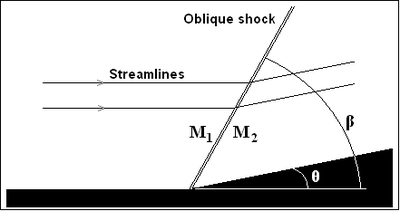
Oblique shock
Encyclopedia

Supersonic
Supersonic speed is a rate of travel of an object that exceeds the speed of sound . For objects traveling in dry air of a temperature of 20 °C this speed is approximately 343 m/s, 1,125 ft/s, 768 mph or 1,235 km/h. Speeds greater than five times the speed of sound are often...
, compressible flow
Compressible flow
Compressible flow is the area of fluid mechanics that deals with fluids in which the fluid density varies significantly in response to a change in pressure. Compressibility effects are typically considered significant if the Mach number of the flow exceeds 0.3, or if the fluid undergoes very large...
. Similar to a normal shock wave, the oblique shock wave consists of a very thin region across which nearly discontinuous changes in the thermodynamic properties of a gas occur. While the upstream and downstream flow directions are unchanged across a normal shock, they are different for flow across an oblique shock wave.
It is always possible to convert an oblique shock into a normal shock by a Galilean transformation
Galilean transformation
The Galilean transformation is used to transform between the coordinates of two reference frames which differ only by constant relative motion within the constructs of Newtonian physics. This is the passive transformation point of view...
.
Oblique Shock Wave Theory


Mach number
Mach number is the speed of an object moving through air, or any other fluid substance, divided by the speed of sound as it is in that substance for its particular physical conditions, including those of temperature and pressure...
, M1, and corner angle, θ, the oblique shock angle, β, and the downstream Mach number, M2, can be calculated. M2 is always less than M1. Unlike after a normal shock, M2 can still be supersonic (weak shock wave) or subsonic (strong shock wave). Nature tends to focus on weak solution. Discontinuous changes also occur in the pressure, density and temperature, which all rise downstream of the oblique shock wave.
the θ-β-M equation
Using the continuity equation and the fact that the tangential velocity component does not change across the shock, trigonometric relations eventually lead to the θ-β-M equation which shows θ as a function of M1 and β.
It is more intuitive to want to solve for β as a function of M1 and θ, but this approach is more complicated, the results of which are often contained in tables or calculated through an applet.
Here is a way to calculate β knowing θ and M1.
First define λ:

Then define χ:

Finally β is given by the relation:

where δ=0 corresponds to the strong shock solution and δ=1 to the weak one.
Maximum deflection angle
Within the θ-β-M equation, a maximum corner angle, θMAX, exists for any upstream Mach number. When θ > θMAX, the oblique shock wave is no longer attached to the corner and is replaced by a detached bow shockBow shock (aerodynamics)
A bow shock, also called a detached shock, is a curved, stationary shock wave that is found in supersonic flow past a finite body. Unlike an oblique shock, the bow shock is not necessarily attached to the tip of the body...
. A θ-β-M diagram, common in most compressible flow textbooks, shows a series of curves that will indicate θMAX for each Mach number. The θ-β-M relationship will produce two β angles for a given θ and M1, with the larger angle called a strong shock and the smaller called a weak shock. The weak shock is almost always seen experimentally.
The rise in pressure, density, and temperature after an oblique shock can be calculated as follows:



M2 is solved for as follows:

Oblique Shock Wave Applications
Oblique shock waves are used predominantly in engineering applications when compared with normal shock waves. This can be attributed to the fact that using one or a combination of oblique shock waves results in more favorable post-shock conditions (lower post-shock temperature, etc.) when compared to utilizing a single normal shock. An example of this technique can be seen in the design of supersonic aircraft engine inlets, which are wedge-shaped to compress air flow into the combustion chamber while minimizing thermodynamic losses. Early supersonic aircraft jet engine inlets were designed using compression from a single normal shock, but this approach caps the maximum achievable Mach number to roughly 1.6. The wedge-shaped inlets are clearly visible on the sides of the F-14 TomcatF-14 Tomcat
The Grumman F-14 Tomcat is a supersonic, twin-engine, two-seat, variable-sweep wing fighter aircraft. The Tomcat was developed for the United States Navy's Naval Fighter Experimental program following the collapse of the F-111B project...
, which has a maximum speed of Mach 2.34.
Many supersonic aircraft wings are designed around a thin diamond shape. Placing a diamond-shaped object at an angle of attack relative to the supersonic flow streamlines will result in two oblique shocks propagating from the front tip over the top and bottom of the wing, with Prandtl-Meyer expansion fan
Prandtl-Meyer expansion fan
A Prandtl–Meyer expansion fan is a centered expansion process, which turns a supersonic flow around a convex corner. The fan consists of an infinite number of Mach waves, diverging from a sharp corner. In case of a smooth corner, these waves can be extended backwards to meet at a point. Each wave...
s created at the two corners of the diamond closest to the front tip. When correctly designed, this generates lift.
Oblique Shock Waves and the Hypersonic Limit
As the Mach number of the upstream flow becomes hypersonic, the equations for the pressure, density, and temperature after the oblique shock wave reach a mathematical limitLimit (mathematics)
In mathematics, the concept of a "limit" is used to describe the value that a function or sequence "approaches" as the input or index approaches some value. The concept of limit allows mathematicians to define a new point from a Cauchy sequence of previously defined points within a complete metric...
. The pressure and density ratios can then be expressed as:


For a perfect atmospheric gas approximation using γ = 1.4, the hypersonic limit for the density ratio is 6. However, hypersonic post-shock dissociation of O2 and N2 into O and N lowers γ, allowing for higher density ratios in nature. The hypersonic temperature ratio is:

See also
- Bow shock (aerodynamics)Bow shock (aerodynamics)A bow shock, also called a detached shock, is a curved, stationary shock wave that is found in supersonic flow past a finite body. Unlike an oblique shock, the bow shock is not necessarily attached to the tip of the body...
- Gas dynamicsGas dynamicsGas dynamics is a branch of fluid dynamics concerned with studying the motion of gases and its consequent effects. Gas dynamics combines the principles of fluid mechanics and thermodynamics...
- Mach reflection
- Moving shockMoving shockIn fluid dynamics, a moving shock is a shock wave that is traveling through a fluid medium with a velocity relative to the velocity of the fluid already making up the medium. As such, the normal shock relations require modification to calculate the properties before and after the moving shock...
- Shock waveShock waveA shock wave is a type of propagating disturbance. Like an ordinary wave, it carries energy and can propagate through a medium or in some cases in the absence of a material medium, through a field such as the electromagnetic field...
- Shock polarShock polarThe term shock polar is generally used with the graphical representation of the Rankine-Hugoniot equations in either the hodograph plane or the pressure ratio-flow deflection angle plane...
External links
- NASA oblique shock wave calculator (Java appletJava appletA Java applet is an applet delivered to users in the form of Java bytecode. Java applets can run in a Web browser using a Java Virtual Machine , or in Sun's AppletViewer, a stand-alone tool for testing applets...
). - Supersonic wind tunnel test demonstration (Mach 2.5) with flat plate and wedge creating an oblique shock(Video)

